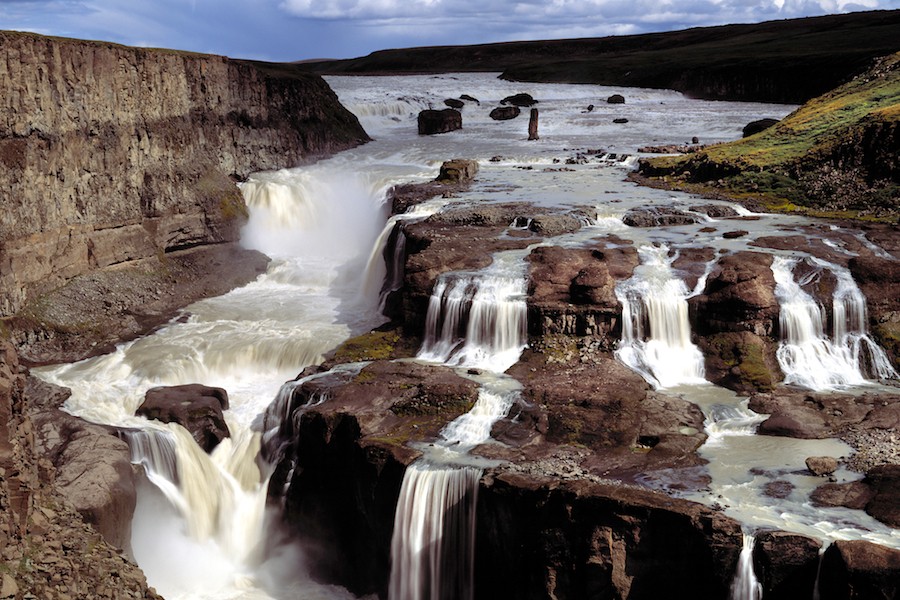Proposals for a river diversion at Norðlingaalda have been rejected for environmental reasons. The construction of the diversion would entail damming the river Þjórsá 8 km downstream from the Þjórsárver Nature Reserve. The flow of waterfalls in the river Þjórsá would be reduced by 40%, in addition to the 30% reduction caused by the construction of the Kvíslar Diversion a quarter of a century ago.
Shortcuts
Norðlingaalda diversion

River Þjórsá
- Norðlingaalda diversion
- See on map
- See photo
- Awaiting further assessment
-
The River Þjórsá
Landsvirkjun has proposed to construct three power plants in the river Þjórsá. Originally, all electricity produced at these power plants was to be sold to Rio Tinto Alcan Iceland Ltd. for the projected extensions of the Straumsvík Aluminum Plant. In a referendum on the proposed extension in 2007, the citizens of Hafnarfjörður township rejected the proposals, and since then, Landsvirkjun has tried to engage other possible buyers for this energy. One example is the proposed aluminum plant in Helgavík, but permission for its construction has as of yet not been granted. There is a further proposal for a river diversion the Norðlingaalda diversion 8 km downstream from the Þjórsárver natural reserve, but this proposal has been classified protected. Nearby, in the river Tungnaá, proposals for the Búðarháls power plant have been given the green light and classified as exploitable.
The three proposed power plants in the lower reaches of the river Þjórsá, namely Hvammur Power Plant, Holt Power Plant and Urriðafoss Power Plant, are currently all classified as awaiting further assessment according to the Master Plan for Hydro and Geothermal Energy Resources. In the initial phase of the Master Plan, all three were classified as exploitable, but in the spring of 2012 when the Master Plan was ratified by parliament, it was decided to reclassify the proposals as awaiting further assessment, and to have the matter looked into more closely before reaching a decision.
Landsvirkjuns plans for harnessing the river Þjórsá have caused a great deal of division and disputes among the inhabitants of the rivers surrounding areas. In some cases, entire families have become divided because of the issue, and the communal spirit in these communities has suffered.
Power plant construction would endanger the areas natural beauty and disrupt the rivers harmonious environs.
Three waterfalls in the river would be destroyed, namely Búði, Hestfoss and Urriðafoss. The waterfalls would be forever silenced, thus greatly altering the experience of visiting the area. Since time immemorial, people have listened to the sound of the river Þjórsá, for example at Búði waterfall and the Núpsflúðir rapids, to make weather predictions and they continue to do so today.
Great disruption could also be caused to the rivers unique ecosystem, and the risk of erosion and dust pollution would be greatly increased due to the river bed partially drying up from diminished water flow.
In addition, construction would take place near the countrys most productive agricultural region and in the immediate vicinity of inhabited areas. Agricultural land would be lost to reservoirs, roads and other construction in relation to the power plants.
Photo © Thorsten Henn
-
Environment
The Þjórsárver wetlands are some of the most important in Iceland. The construction of the Norðlingaalda Diversion would destroy this area. Þjórsárver is on the Ramsar list of wetlands of international importance, as well as making the list of Important Bird Areas (IBA), besides being considered one of the most important wetlands in Northern Europe.
Photo © RAX
-
Power Proposals
The construction of the Norðlingaalda Diversion entails damming the river Þjórsá approximately 8 km downstream from the Þjórsárver natural reserve, thus forming a reservoir with an area of roughly 5 km². From there, a tunnel would channel water to Lake Þórisvatn. The Norðlingaalda Diversion is therefore not a power plant as such, but is meant to divert a portion of the Þjórsá river flow to Lake Þórisvatn, Landsvirkjuns main water reservoir, so that more power can be generated at power plants in Vatnsfell, Sigalda, Hrauneyjafoss and Búðarháls.
Photo © Ólafur Sigurjónsson










